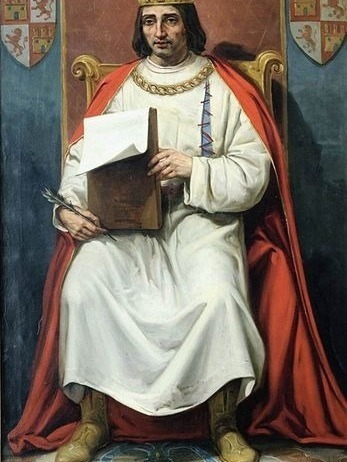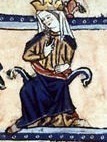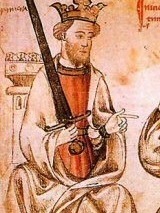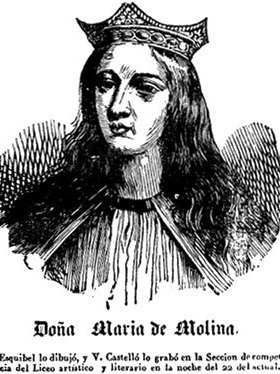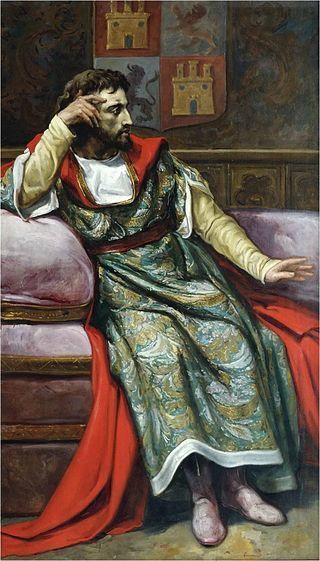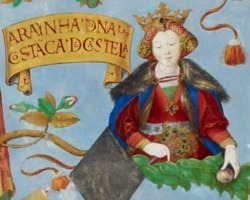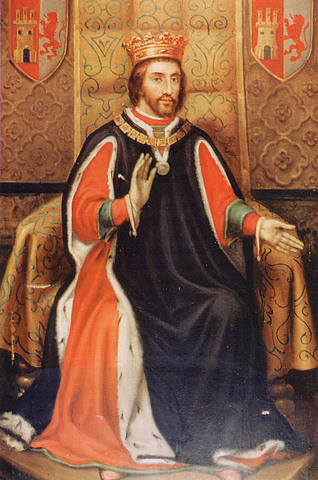Family Tree of Carlos Spartacus. » King Ferdinand IV (Fernando) "the Summoned" King of Castile León and Galicia (King Ferdinand IV (Fernando) "the Summoned", King of Castile, León and Galicia) (1285-1312)
Persoonlijke gegevens King Ferdinand IV (Fernando) "the Summoned" King of Castile León and Galicia (King Ferdinand IV (Fernando) "the Summoned", King of Castile, León and Galicia)
- Roepnaam King Ferdinand IV (Fernando) "the Summoned", King of Castile, León and Galicia.
- Hij is geboren op 6 december 1285.
- Hij is overleden op 7 september 1312, hij was toen 26 jaar oud.
- Een kind van King Sancho IV "The Brave" King of Castile Leon and Galicia (house Bourgogne) en Queen Maria de Molina Queen of Castile
Gezin van King Ferdinand IV (Fernando) "the Summoned" King of Castile León and Galicia (King Ferdinand IV (Fernando) "the Summoned", King of Castile, León and Galicia)
Hij had een relatie met Queen Consort Constança Queen of Castile Infanta de Portugal.
Kind(eren):
Notities over King Ferdinand IV (Fernando) "the Summoned" King of Castile León and Galicia (King Ferdinand IV (Fernando) "the Summoned", King of Castile, León and Galicia)
Web content link:https://en.wikipedia.org/wiki/Ferdinand_IV_of_Castile biography
Ferdinand IV of Castile (6 December 1285 – 7 September 1312) called the Summoned (el Emplazado), was a King of Castile and León from 1295 until his death.
During his minority, his upbringing and the custody of his person were entrusted to his mother, Queen María de Molina, while his tutorship was entrusted to the Infante Henry of Castile the Senator, son of King Fernando III of Castile. At that time, and also for the rest of his reign, his mother tried to placate the nobility, confronted her son's enemies, and repeatedly prevented Ferdinand IV from being dethroned.
He had to face the insubordination of the nobility, led at numerous times by his uncle, the Infante John of Castile, Lord of Valencia de Campos and by Juan Núñez II de Lara, who were supported in some occasions by Juan Manuel, Prince of Villena and grandson of the King Ferdinand III.
Like his predecessors on the throne, Ferdinand IV continued the Reconquista and, although he failed to conquer Algeciras in 1309, he captured the city of Gibraltar that same year, and in 1312 the city of Alcaudete was also conquered. During the Cortes of Valladolid of 1312, he promoted the reform of the administration of justice, and that of all areas of administration, while attempting to strengthen the royal authority to the detriment of the nobility. He died in Jaén on 7 September 1312 aged 26, and his mortal remains are now in the Royal Collegiate Church of Saint Hippolytus.
Contents [hide]
1Life
1.1Infancy (1285–1295)
1.2Reign (1295–1312)
1.2.1Under regency (1295–1301)
1.2.1.1The Treaty of Alcañices (1297)
1.2.1.2Last stage of minority (1297–1301)
1.2.2Personal rule (1301–1312)
1.2.2.1Meeting of Ariza and death of Henry of Castile (1303)
1.2.2.2Treaty of Torrellas (1304)
1.2.2.3Treaty of Elche (1305)
1.2.2.4Conflicts over the possession of the Lordship of Biscay (1305–1307)
1.2.2.5Internal conflicts in Castile and meeting of Grijota (1307–1308)
1.2.2.6Treaty of Alcalá de Henares (1308)
1.2.2.7The conquest of Gibraltar and the siege of Algeciras (1309)
1.2.3Last years and death (1310–1312)
1.2.3.1Conflicts with John of Castile and Juan Manuel of Villena (1310–1311)
1.2.3.2Concord of Palencia and meeting of Calatayud (1311–1312)
1.2.4Last period of the Ferdinand IV's life (1312)
1.2.4.1Different versions of the king's death
2Burial
3Marriage and Issue
4Ancestry
5Notes
6References
7Further reading
7.1General consultation works
7.2Specific works about Ferdinand IV and his time
7.3Specific articles appeared in books and publications about Ferdinand IV and his time
7.4Historical novels
7.5Plays
Life[edit]
Infancy (1285–1295)[edit]
Seal of Sancho IV of Castile, Ferdinand IV's father.
Ferdinand was born in the city of Seville on 6 December 1285 as the second child and eldest son of King Sancho IV of Castile and his wife María de Molina. He was baptized at Seville Cathedral by Archbishop Raimundo de Losana and was immediately proclaimed heir to the Crown and received the homage of the nobles of the Kingdom.[1]
King Sancho IV entrusted to Fernán Pérez Ponce de León the raising of his newborn son, since he had been First Majordomo of King Alfonso X. The prince and his tutor left for the city of Zamora, where the family of Fernán Pérez resided. Likewise the King appointed Isidro González and Alfonso Godínez as Chancellors of the prince, while appointing Samuel de Belorado almojarife (Treasurer) of the prince. Fernán Pérez Ponce de León and his wife, Urraca Gutiérrez de Meneses, had a significant influence on Ferdinand's character, and he would show them, as a King, a profound gratitude.[2]
Already in his infancy the question of his marriage was raised, being the desire of Sancho IV to choose a princess from Kingdoms of France of Portugal. In the agreement signed by Sancho IV and King Denis of Portugal in September 1291, was established the betrothal between Ferdinand and the Infanta Constance, daughter of the Portuguese sovereign. Nevertheless, in spite of the commitment contracted with the Portuguese monarch, in 1294, Sancho IV thought about the possibility of marrying his son with Margaret or Blanche, daughters of King Philip IV of France. The death of Sancho IV a year later put an end to the negotiations with the French court.
Reign (1295–1312)[edit]
Under regency (1295–1301)[edit]
King Sancho IV of Castile died in the city of Toledo on 25 April 1295, leaving his eldest son Ferdinand as heir of the throne. After the burial of the sovereign at Toledo Cathedral, his widow María de Molina retired to the Alcázar of Toledo for a mourning of nine days. The now Dowager Queen was in charge of the regency of her 9-years-old son. Because the marriage between Sancho IV and María de Molina was without validity, all their children (including the now Ferdinand IV) were illegitimate, so the Dowager Queen had to face numerous problems to keep her son in the throne.[3]
To the incessant struggles with the Castilian nobility, led by the Infante John of Castile, Lord of Valencia de Campos (who claimed the throne of his brother Sancho IV) and by the Infante Henry of Castile the Senator, son of Ferdinand III and great-uncle of Ferdinand IV (who demanded the guardianship of the king) are joined the claims of the Infantes de la Cerda (Alfonso and Ferdinand, sons of the deceased first-born son of Alfonso X, Ferdinand de la Cerda), who were supported by France and Aragon and by their grandmother Dowager Queen Violante of Aragon, widow of Alfonso X. To this were added the problems with Aragon, Portugal and France, who tried to take advantage of the political instability that suffered the Kingdom of Castile in their own benefit. At the same time, Diego López V de Haro, Lord of Biscay, Nuño González de Lara, and Juan Núñez II de Lara, among many others nobles, sowed confusion and anarchy in the kingdom.
María de Molina shows her Ferdinand IV in the Cortes of Valladolid of 1295, by Antonio Gisbert, 1863. Currently displayed in the Congress of Deputies, Spain.
In the Cortes of Valladolid in 1295, Henry of Castile the Senator was appointed guardian of the King, but the Dowager Queen María de Molina got (thanks to the support of the cities with votes in the Cortes) that the custody of her son was entrusted to her. While celebrating the Cortes of Valladolid, John of Castile, Lord of Valencia de Campos, left the city of Granada and tried to occupy the city of Badajoz, but, when failing in this attempt, he seized Coria and the castle of Alcántara. He later passed to the Kingdom of Portugal, where he pressed King Denis of Portugal to declare war to Castile and, at the same time, to support his claims to the Castilian throne.[4]
In the summer of 1295, when the Cortes of Valladolid were finished, the Dowager Queen and Henry of Castile met in Ciudad Rodrigo with King Denis of Portugal, to whom they delivered several localities located near the Portuguese border. In the meeting of Ciudad Rodrigo was renewed the betrothal between Ferdinand IV and Constance of Portugal, daughter of King Denis, and in addition Infanta Beatrice of Castile, younger sister of Fernando IV, would marry Afonso, heir to the Portuguese throne. At the same time, Diego López V de Haro was confirmed the possession of the Lordship of Biscay, and John of Castile, who recognized (but only privately) Ferdinand IV as his sovereign, was momentarily restored his property.[5] Shortly after, King James II of Aragon returned the Infanta Isabella of Castile to the Castilian court without having married with her, and declared the war to the Kingdom of Castile.
At the beginning of 1296, John of Castile rebelled against Ferdinand IV and took Astudillo, Paredes de Nava and Dueñas, while his son Alfonso of Valencia seized Mansilla. In April 1296 Alfonso de la Cerda invaded the Kingdom of Castile accompanied by Aragonese troops, and went to the city of León, where John of Castile was proclaimed King of León, Seville and Galicia. Immediately afterwards, John of Castile accompanied Alfonso de la Cerda to Sahagún, where he was proclaimed King of Castile, Toledo, Córdoba, Murcia and Jaén. Shortly after being crowned Alfonso de la Cerda and John of Castile, both surrounded the Valladolid municipality of Mayorga, while Henry of Castile parted to the Kingdom of Granada to arrange the peace between the Sultan Muhammed II al-Faqih and Ferdinand IV, since the Granadian troops attacked in those moments in all Andalusia the lands of the King, that were defended, among others, by Alonso Pérez de Guzmán. On 25 August 1296, the Infante Peter of Aragon died victim of the plague while he was under the command of the Aragonese army that surrounded the city of Mayorga, losing with him John of Castile one of his main supporters. Due to the mortality that extended between the besiegers of Mayorga, their commanders were forced to raise the siege.[6]
While John of Castile and Juan Núñez II de Lara waited for the arrival of the King of Portugal with his troops to join them in the siege of the city of Valladolid, where the Dowager Queen María de Molina and Ferdinand IV took refuge, the Aragonese monarch attacked Murcia and Soria, and King Denis of Portugal attacked along the line of Douro river, while Diego López V de Haro sowed disorder in his Lordship of Biscay.
When Henry of Castile, who was conferring with the Sultan of Granada, learned that the Aragonese and the Portuguese had left the Kingdom of Castile, and that the Dowager Queen was besieging Paredes de Nava, he decided to return to Castile, fearing that he would be deprived from his position of guardian of Ferdinand IV. However, under pressure from Alonso Pérez de Guzmán and other knights he attacked the Granadians, who at that time had again attacked the Castilians. Four leagues from Arjona, a battle was fought with the Granadians, in which Henry of Castile had lost his life if Alonso Pérez de Guzmán had not saved him, for the Castilians the defeat was complete, and their camp was looted.[7] After his return to Castile, Henry of Castile persuaded some knights to leave the siege of Paredes de Nava, despite the opposition of the Dowager Queen, that returned to Valladolid in January 1297 without having taken that.
During the Cortes de Cuellar of 1297, summoned by the Dowager Queen María de Molina, Henry of Castile wanted that the city of Tarifa would be returned to the Sultan of Granada, but he was unable to achieve his objective due to the opposition of María de Molina. In these Cortes Henry of Castile managed to obtain for his nephew Juan Manuel, Prince of Villena the Castle of Alarcón in compensation for having lose the town of Elche after being conquered by the Aragonese, despite the opposition of the Dowager Queen, who didn't want to established such precedents between Castilian nobles and magnates. Shortly before the signing of the Treaty of Alcañices, Juan Núñez II de Lara, who supported Alfonso de la Cerda and John of Castile, was besieged in Ampudia, although he managed to escaped from the siege.
full bio here: https://en.wikipedia.org/wiki/Ferdinand_IV_of_Castile
Tijdbalk King Ferdinand IV (Fernando) "the Summoned" King of Castile León and Galicia (King Ferdinand IV (Fernando) "the Summoned", King of Castile, León and Galicia)
 grootouders
grootouders
 ouders
ouders
 broers/zussen
broers/zussen
 kinderen
kinderen
Voorouders (en nakomelingen) van King Ferdinand IV (Fernando) "the Summoned" King of Castile León and Galicia
Verwantschap King Ferdinand IV (Fernando) "the Summoned" King of Castile León and Galicia (King Ferdinand IV (Fernando) "the Summoned", King of Castile, León and Galicia)
- King Ferdinand IV (Fernando) "the Summoned" King of Castile León and Galicia is de achter(x16)kleinzoon van Emperor Charlemagne "the great" Charles the Great Charles I King of the Franks (768+) King of the Lombards (774+) Emperor of the Romans (800/814) /814):Emperor Charlemagne "the great" Charles the Great Charles I King of the Franks (768+) King of the Lombards (774+) Emperor of the Romans (800/814) /814)King Pippin Carloman King Of Italy of ItalyKing Bernard. King of Italy (Carolingean House)Count Seigneur Pépin de Peronne Count of Peronne and St. Quentin in the Vermandois (Carolingean House)Count Herbert / Heribert I Count of Senlis and Vermandois (Carolingean House)Queen Béatrice of Vermandois (Carolingian House) Queen Consort of Western Francia De'Vermandois (Queen of Western Francia)Duke Hughes "the Great" Duke of the Franks and Count of Paris.(House Capet) capetKing Hugh / Hugo Capet King of France (House Capet) CapetKing Robert II "the Pious" King of Franks CapetDuke Robert I 'the old' / "Tete-Hardi" Duke of Bourgogne / Burgundy (House Capet) Bourgogne (Capet)Constance de BourgogneUrraca (Hourse Jimenez) "The Reckless", Queen Regnant of León, Castile, and GaliciaKing Alfonso VII Alfonso Raimúndez "the Emperor" King of Galicia(1111+) King of León and Castile (+1126). Emperor of all Spain, House of IvreaKing Ferdinand II King of León and GaliciaKing Alfonso IX "The Slobberer" King of León & Galicia (House Anscarid)King Ferdinand III (Fernando) "the saint" King of Castile León and GaliciaKing Alfonso X ( Afonso Alphonso Alphonse or Alfons ) "The Wise" King of Castile León and GaliciaKing Sancho IV "The Brave" King of Castile Leon and Galicia (house Bourgogne)King Ferdinand IV (Fernando) "the Summoned" King of Castile León and Galicia
- King Ferdinand IV (Fernando) "the Summoned" King of Castile León and Galicia is de achter(x9)kleinzoon van King Hugh / Hugo Capet King of France (House Capet) Capet:King Hugh / Hugo Capet King of France (House Capet) CapetKing Robert II "the Pious" King of Franks CapetDuke Robert I 'the old' / "Tete-Hardi" Duke of Bourgogne / Burgundy (House Capet) Bourgogne (Capet)Constance de BourgogneUrraca (Hourse Jimenez) "The Reckless", Queen Regnant of León, Castile, and GaliciaKing Alfonso VII Alfonso Raimúndez "the Emperor" King of Galicia(1111+) King of León and Castile (+1126). Emperor of all Spain, House of IvreaKing Ferdinand II King of León and GaliciaKing Alfonso IX "The Slobberer" King of León & Galicia (House Anscarid)King Ferdinand III (Fernando) "the saint" King of Castile León and GaliciaKing Alfonso X ( Afonso Alphonso Alphonse or Alfons ) "The Wise" King of Castile León and GaliciaKing Sancho IV "The Brave" King of Castile Leon and Galicia (house Bourgogne)King Ferdinand IV (Fernando) "the Summoned" King of Castile León and Galicia
- King Ferdinand IV (Fernando) "the Summoned" King of Castile León and Galicia is de achter(x22)kleinzoon van King Ceolwald King of Wessex of Wessex:King Ceolwald King of Wessex of WessexCoenred of Wessex (Wessex)Ingild of Wessex (Wessex)Eoppa King of Wessex of WessexEafa King of Wessex of WessexKing EALHMUND King of Wessex of Kent (Wessex)Egbert King of Wessex (802-839) ( Ecgberht / Ecgbert / Ecgbriht ) of WessexAethelwulf King of Wessex (839-858) King of WessexAlfred The Great King of Wessex (871-899) of WessexKing Edward "The Elder",King of the Anglo-Saxons (899-924) King of the Anglo-SaxonsKing Edmund I King of England (939-946),"the Deed-doer" the "Just" or "the Magnificent" of EnglandKing Edgar the Peaceful King of England of EnglandKing Ethelred II "'the Unready' King of England (978 – 1013) and (1014-1016) of EnglandKing Edmund II 'Ironside' King of England (1016) AthelingEdward 'Edward the Exile' AthelingMargaret CeannmoreEadgith Edith of ScotlandMatilda (Maud) "Holy Roman Empress Lady of the English" de Anjou, of NormandieHenry (Henry II) "King of England Curtmantle FitzEmpress" House of PlantagenetEleanor of england of Castile daughter of Eleanor of Aquitaine House of PlantagenetBerengaria Queen Regnant Castile & Queen Consort Infanta of Castile de CastillaKing Ferdinand III (Fernando) "the saint" King of Castile León and GaliciaKing Alfonso X ( Afonso Alphonso Alphonse or Alfons ) "The Wise" King of Castile León and GaliciaKing Sancho IV "The Brave" King of Castile Leon and Galicia (house Bourgogne)King Ferdinand IV (Fernando) "the Summoned" King of Castile León and Galicia
- King Ferdinand IV (Fernando) "the Summoned" King of Castile León and Galicia is de achter(x11)kleinzoon van Duke Rolf (Rollo) "The Ganger" 1st Duke of Normandy /Hrólfsdóttir Ragnvaldsson:Duke Rolf (Rollo) "The Ganger" 1st Duke of Normandy /Hrólfsdóttir RagnvaldssonGeirlaug (Gerloc) Hrólfsdóttir (from Normandy) HrólfsdóttirAdelais de AquitaineKing Robert II "the Pious" King of Franks CapetDuke Robert I 'the old' / "Tete-Hardi" Duke of Bourgogne / Burgundy (House Capet) Bourgogne (Capet)Constance de BourgogneUrraca (Hourse Jimenez) "The Reckless", Queen Regnant of León, Castile, and GaliciaKing Alfonso VII Alfonso Raimúndez "the Emperor" King of Galicia(1111+) King of León and Castile (+1126). Emperor of all Spain, House of IvreaKing Ferdinand II King of León and GaliciaKing Alfonso IX "The Slobberer" King of León & Galicia (House Anscarid)King Ferdinand III (Fernando) "the saint" King of Castile León and GaliciaKing Alfonso X ( Afonso Alphonso Alphonse or Alfons ) "The Wise" King of Castile León and GaliciaKing Sancho IV "The Brave" King of Castile Leon and Galicia (house Bourgogne)King Ferdinand IV (Fernando) "the Summoned" King of Castile León and Galicia
- King Ferdinand IV (Fernando) "the Summoned" King of Castile León and Galicia is de achter(x15)kleinzoon van Gregor (Kenneth I) "Giric Cináed mac Ailpín King of Picts of Scotland (MacAlpin):Gregor (Kenneth I) "Giric Cináed mac Ailpín King of Picts of Scotland (MacAlpin)King Constantine "Causantin mac Cináeda" King of Picts of Scotland (MacAlpin)King Domnall mac Causantín (Donald II) King of Picts "Domnall the Madman of Scotland (MacAlpin)King Malcolm "Mael Coluim King of Alba" of Scotland (MacAlpin)King Kenneth mac Máel Coluim (Kenneth II) "Cináed King of Alba" of Scotland (MacAlpin)King Malcolm II Mael Coluim King of Scotland "The Destroyer" Canmore House of Alpin aka Clann Chinaeda meic Ailpín Kings of the Picts of Scotland (MacAlpin)Bethóc of ScotlandKing Duncan I "Donnchad mac Crínáin King of Strathclyde King of the Scots" of Scotland (Dunkeld)King Malcolm III "Canmore Ceannmore King of the Scots King of Cumbrians Maol Chaluim mac Dhonnchaidh" of Scotland formerly Dunkeld aka MacDuff Ceannmore (Dunkeld)Eadgith Edith of ScotlandMatilda (Maud) "Holy Roman Empress Lady of the English" de Anjou, of NormandieHenry (Henry II) "King of England Curtmantle FitzEmpress" House of PlantagenetEleanor of england of Castile daughter of Eleanor of Aquitaine House of PlantagenetBerengaria Queen Regnant Castile & Queen Consort Infanta of Castile de CastillaKing Ferdinand III (Fernando) "the saint" King of Castile León and GaliciaKing Alfonso X ( Afonso Alphonso Alphonse or Alfons ) "The Wise" King of Castile León and GaliciaKing Sancho IV "The Brave" King of Castile Leon and Galicia (house Bourgogne)King Ferdinand IV (Fernando) "the Summoned" King of Castile León and Galicia
De getoonde gegevens hebben geen bronnen.
Historische gebeurtenissen
Geboortedag 6 december 1285
- Graaf Floris V (Hollands Huis) was van 1256 tot 1296 vorst van Nederland (ook wel Graafschap Holland genoemd)
Dag van overlijden 7 september 1312
- Graaf Willem III de Goede (Henegouws Huis) was van 1304 tot 1337 vorst van Nederland (ook wel Graafschap Holland genoemd)
Dezelfde geboorte/sterftedag
- 1285 » Ferdinand IV van Castilië koning van Castilië en León († 1312)
- 1421 » Koning Hendrik VI van Engeland († 1471)
- 1478 » Baldassare Castiglione, Italiaans diplomaat en schrijver († 1529)
- 1586 » Niccolò Zucchi, Italiaans astronoom († 1670)
- 1608 » George Monck, Engels militair († 1670)
- 1637 » Edmund Andros, Engels gezagvoerder († 1714)
- 1134 » Alfons I van Aragón (61), koning van Aragón
- 1151 » Godfried V (38), graaf van Anjou
- 1559 » Robert Estienne (57), Frans drukker
- 1809 » Rama I (72), koning van Thailand
- 1829 » François Adriaan van der Kemp (77), Nederlands patriot
- 859 » Xuān Zong (49), keizer van China
Carlos Fernando de Souza Silva Brogni, "Family Tree of Carlos Spartacus.", database, Genealogie Online (https://www.genealogieonline.nl/family-tree-of-carlos-fernando-de-souza-silva/I501445.php : benaderd 30 april 2024), "King Ferdinand IV (Fernando) "the Summoned" King of Castile León and Galicia (King Ferdinand IV (Fernando) "the Summoned", King of Castile, León and Galicia) (1285-1312)".
